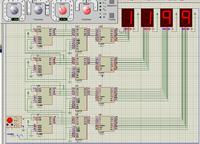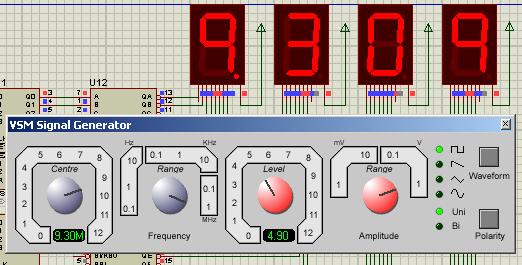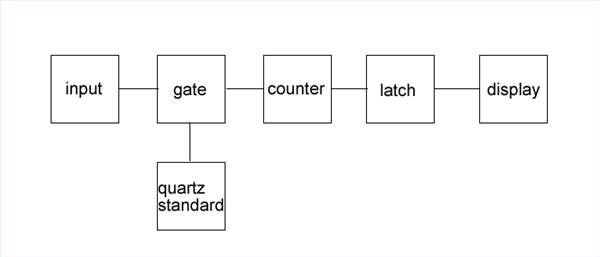ALERTLINKS
Advanced Member level 4

Practically 7490 is good for upto 40MHz. A 4 digit display showing for example 36.76MHz can be achived. Similarly setting duty cycle to 95% (5% time for counting and rest of the time for display) will divide by 10.
1.2MHz display with 50Hz clock with 95% duty cycle.

After adding decimal point for making count from 0 to 9.999MHz and adjusting initial rising pulse and with 5% duty cycle.

Resolution is now 1KHz. That means you will get 0 reading until your input pass 999Hz. Display will show 1 at 1000Hz-1999Hz.
There are frequency dividers used for higher frequencies to divide incoming signal before entering frequency counters often called prescaler.
https://www.answers.com/topic/prescaler
https://en.wikipedia.org/wiki/Prescaler
From initial posts,
Does it make sense now?
1.2MHz display with 50Hz clock with 95% duty cycle.

After adding decimal point for making count from 0 to 9.999MHz and adjusting initial rising pulse and with 5% duty cycle.

Resolution is now 1KHz. That means you will get 0 reading until your input pass 999Hz. Display will show 1 at 1000Hz-1999Hz.
There are frequency dividers used for higher frequencies to divide incoming signal before entering frequency counters often called prescaler.
https://www.answers.com/topic/prescaler
https://en.wikipedia.org/wiki/Prescaler
From initial posts,
It is fine to reduce the time window so that it will divide by 10 or 100 or 1000, in case your incoming frequency is too high for your 3 digits to accommodate.
Likewise you can extend the time window to 10 seconds, so that the counter can handle an incoming frequency slower than 1 Hz.
@BradtheRad
It is fine to reduce the time window so that it will divide by 10 or 100 or 1000, in case your incoming frequency is too high for your 3 digits to accommodate.
Likewise you can extend the time window to 10 seconds, so that the counter can handle an incoming frequency slower than 1 Hz.
Sorry sir, didn't understand this.
Does it make sense now?



